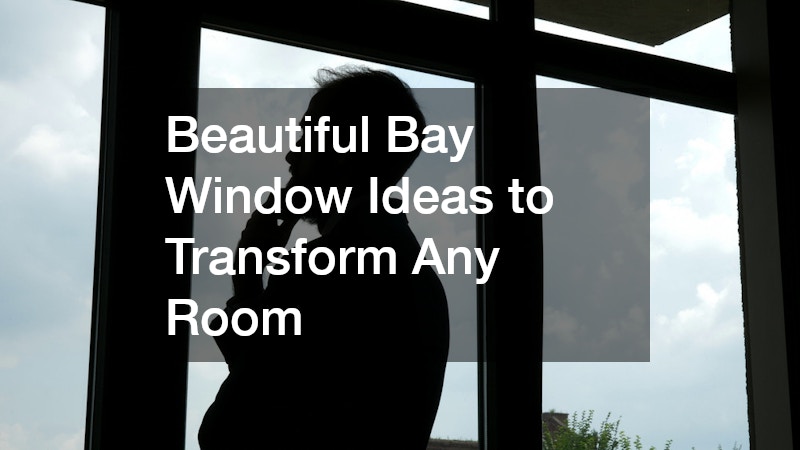Bay windows are a timeless architectural feature that can significantly enhance both the aesthetic and functional aspects of a room. With their unique protruding structure, they not only add extra square footage but also maximize the intake of natural light, creating a brighter and more spacious feel. Their versatile nature makes them suitable for various rooms in a home, from living rooms to bedrooms, fundamentally transforming the way these spaces are used and experienced.
How can I enhance the functionality of my bay windows?
Adding Built-In Seating
One popular method to boost the functionality of bay windows is by installing built-in seating. These cozy nooks provide a comfortable spot to relax while basking in natural light, making them perfect for reading or enjoying your morning coffee.
Built-in seating can be customized to match the room’s décor, allowing homeowners to blend their personal style with the practical benefits of bay windows.
With cushions and throw pillows, these seating areas become inviting retreats within your home. This additional seating option not only enhances comfort but also serves as an innovative way to utilize the space effectively. Comfortable seating transforms bay windows from mere architectural features into essential components of living spaces.
Incorporating Storage Solutions
Bay windows offer a unique opportunity to incorporate additional storage without compromising style. By integrating elements like shelving, cabinets, or benches with built-in storage, you can make the most of the space beneath or adjacent to the windows. This clever use of space helps keep rooms organized and clutter-free.
Storage solutions can be customized to suit specific needs, whether it’s to house books, display treasured items, or store everyday essentials out of sight. Selecting storage options in materials and finishes that complement existing décor helps ensure a cohesive design throughout the room. These solutions transform bay window areas into not only focal points but highly functional parts of the living space.
Creating a Multi-Use Space
Bay windows are perfect for creating multi-functional spaces that cater to a variety of uses. By furnishing these areas with versatile elements, such as collapsible tables or adjustable seating, you can transform a single bay window into a reading nook, a dining alcove, or a mini office. The flexibility of these spaces means they can adapt easily to changing needs, offering endless possibilities for use.
In a time where home offices and quiet spaces are more valued than ever, bay windows can be turned into areas that facilitate productivity and relaxation. Whether you’re working remotely or need a tranquil corner to unwind, the abundance of natural light and views offered by bay windows enhances this experience. Creating multi-use spaces maximizes the potential of bay windows, allowing them to serve significant roles in daily life.
Design ideas to make bay windows stand out
Using Decorative Window Treatments
Decorative window treatments can significantly alter the appearance and mood of bay windows, elevating their impact within a space. Curtains, valances, and blinds offer various styles and functionalities, from filtering light to providing privacy and framing the window itself. By carefully choosing the right fabric, color, and pattern, window treatments can either complement or stand out within the room’s design scheme.
Layered treatments add depth and texture, creating interesting visual effects that draw attention to the bay windows. The strategic use of different curtain styles or combinations, like sheers coupled with heavier drapes, allows homeowners to control light and privacy effectively. Incorporating decorative elements, such as tiebacks or curtain rods, enhances the elegance and sophistication of window treatments.
Choosing the Right Bay Window Styles
Selecting the appropriate bay window style is crucial in aligning with the overall architectural theme of a home. From traditional designs to contemporary forms, or the ornate details of Victorian styles, bay windows can be tailored to fit diverse aesthetics and preferences. Understanding the different styles and their characteristics ensures harmony with the home’s existing design language.
Traditional bay windows often feature wooden frames and mullions, providing a classic and timeless appeal suitable for many homes. Contemporary styles, with their clean lines and minimalistic approach, offer a modern take that works well with urban or industrial-themed interiors. Victorian bay windows, on the other hand, are known for their intricate detailing and grandeur, perfect for adding a touch of elegance to a more formal space.
The best lighting options for bay windows
Taking full advantage of the natural light that bay windows provide is essential for optimizing room ambiance and function. By keeping windows unobstructed and selecting light-enhancing furnishings such as mirrors, the light entering the space can be amplified. Strategic placement of reflective surfaces can help distribute light evenly, reducing the need for artificial lighting during the day.
Ambient lighting also plays a pivotal role in complementing the natural light offered by bay windows, ensuring balanced illumination throughout the day and night. Fixtures such as pendant lights, chandeliers, or wall sconces can be used to create soft, diffused light that enhances the room’s warmth and coziness. Selecting fixtures that align with the room’s style can add a decorative element, establishing a coherent design.
By exploring different ways to optimize bay windows, we not only enrich our living spaces aesthetically but also improve the quality of our everyday experiences. These unique architectural features can dramatically influence the look and feel of a room, serving both practical needs and enhancing comfort. Bay windows continue to be timeless elements of home design, proving their value as both functional and decorative enhancements.
.



